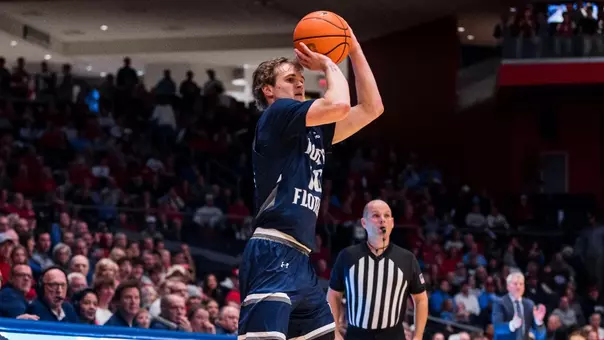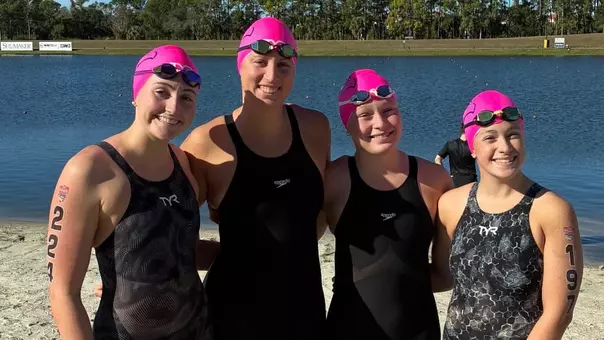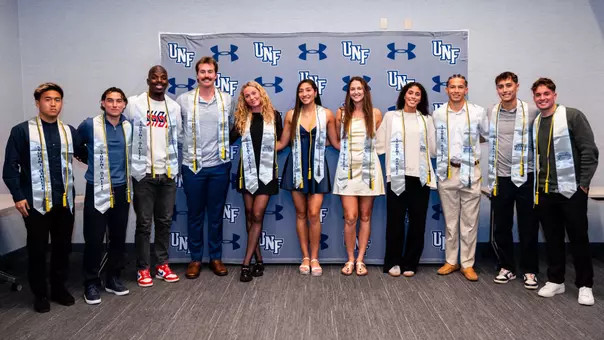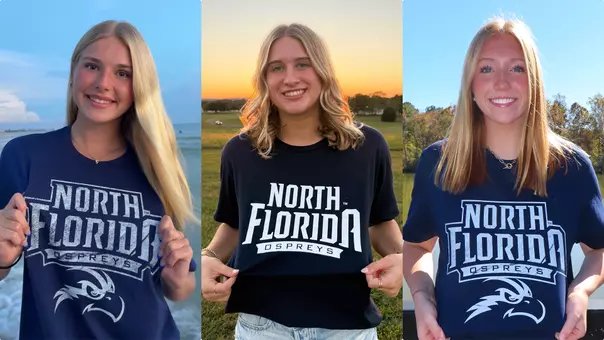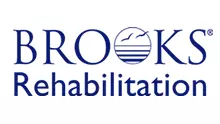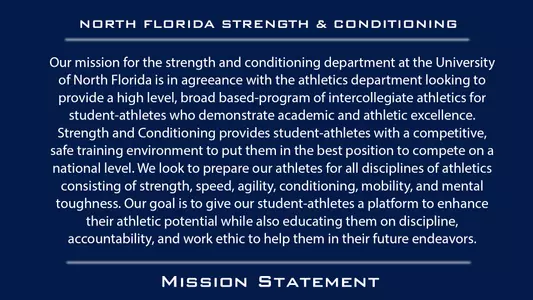
Strength & Conditioning Mission Statement & Philosophy
12/28/2021 3:23:00 PM | Strength & Conditioning
MISSION
Our mission for the strength and conditioning department at the University of North Florida is in agreeance with the athletics department looking to provide a high level, broad based-program of intercollegiate athletics for student-athletes who demonstrate academic and athletic excellence…. Strength and Conditioning provides student-athletes with a competitive, safe training environment to put them in the best position to compete on a national level. We look to prepare our athletes for all disciplines of athletics consisting of strength, speed, agility, conditioning, mobility, and mental toughness. Our goal is to give our student-athletes a platform to enhance their athletic potential while also educating them on discipline, accountability, and work ethic to help them in their future endeavors.PHILOSOPHY
The University of North Florida strength and conditioning department aims to enhance overall athletic potential while decreasing the risk of injury through ground based tri-planar movements using sport-specific, research based programming methodology. The department looks to increase strength, power, agility, cardiovascular fitness, flexibility, and mobility while also educating the student-athletes on proper nutrition and recovery habits to enable preparedness for their respective competitive seasons.
Through our program we also look to instill discipline, accountability, mental toughness, and an industrious behavior to help prepare them for future endeavors. We provide individualized, sport-specific programs within a group setting. Our goal is to provide the student-athletes with the tools needed to compete at the Division-1 level while also educating them with skills they can carry throughout their life.
OSPREY STRENGTH | FIVE PILLARS OF SUCCESS (CULTURE CREATES CHAMPIONSHIPS)

Structure: Our program is based off a structured systematic approach from our foundation of employee organization, tasks and duties to program development for our student-athletes based on our philosophy.
Philosophy: Science-based, practical approach to strength and conditioning.
Communication: Free and easy transfer of information between our staff, athletes, coaches, athletic training staff and administration.
Industriousness: Taking initiative to acquire new knowledge while thinking progressively with ingenuity in mind. Diligent work ethic.
Integrity – adherence to moral and ethical principles, possessing qualities of honesty and accountability
TRAINING PHILOSOPHY | STANDARD UNF STRENGTH & CONDITIONING SESSION
Mental Training – Each lift begins with mental preparation, individualized on a team-by-team basis. Our mental training entails a quote, purpose, focus, and challenge pertaining to each day. We believe that focusing on things such as these help prepare our athletes both for the workout at hand and the season or offseason ahead.Warm-up/Movement Prep – Warmups at UNF consist of ground-base, tri-planar movements that engage the entire body in preparation for the training session. Additionally, these warmups are intended to increase muscle temperature and central nervous system firing. Along with the initial movement-based warmup, we incorporate muscle activation techniques designed to fire the according primary and tertiary muscles utilized in a given day's training. This time block also allows us to incorporate any necessary corrective exercises in order to decrease the risk of injury.
Plyometrics – We apply sequential plyometric training, starting with low-impact, single-response movements and moving towards high-impact, multi response movements, all phases of which ultimately cover unilateral, bilateral, linear, lateral, rotational, and multidirectional upper/lower body movement patterns. This method of plyometric training is intended to prepare an athlete's body for sport by way of CNS activation, joint stabilization, and strengthening of the tendons and ligaments used in high-velocity movements.
Training – The structure of our lift has a systematic approach, beginning with high-coordination, explosive movements, leading into core/structural strength-based movements, and ending with multi-purpose auxiliary movements. We incorporate single/multi-joint and uni/bilateral movements into our programming in order to create a thorough and comprehensive training protocol. The UNF Strength and Conditioning Department aims to enhance overall athletic potential while decreasing the risk of injury through, ground-based, tri-planar movements using sport-specific, research based programming methodology.
Core – The basis of our core training involves a periodized approach, starting with static exercises encompassing bracing/stabilization, leading to more dynamic and specific movements based on the unique demands of each sport.
Cooldown – A cooldown indicates a period of low-impact movements or stretches to allow the body to gradually return to its natural baseline. Pairing this cooldown with our performance training helps to promote recovery and facilitate the process of our athletes' bodies returning to normal physiological levels.
SAQ/Conditioning – Specific speed, agility, quickness, and conditioning work will vary from sport to sport. However, the fundamentals of our SAQ/conditioning training remain the same. Our protocol encompasses the development of linear, lateral, and multidirectional speed/agility/quickness by using planned/reactive drills, an emphasis on movement efficiency, and sensible, understandable progressions that our athletes are able to execute.
Testing – Performance testing provides methods with which to quantify an athlete's capabilities. Our staff utilizes a number of different tests in order to accurately measure an athlete's muscular strength, power, endurance, and range of motion, as well as aerobic/anaerobic capabilities. We use these tests to determine where the athlete excels or is deficient. Additionally, the information gathered from these tests helps us identify trends among the performance of an entire team throughout the year, thereby enabling us to create a more specific, effective training program.
